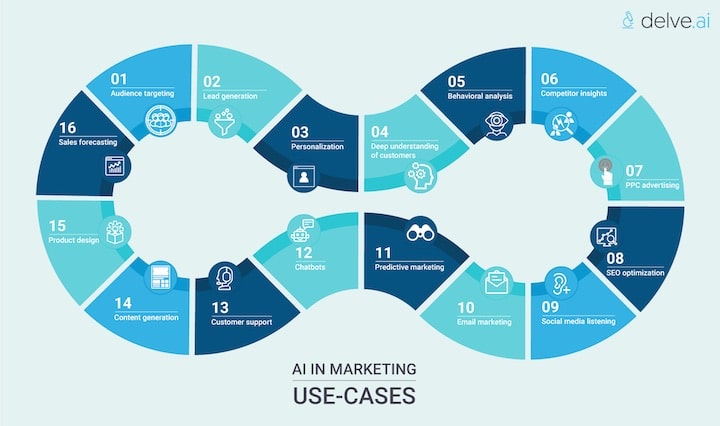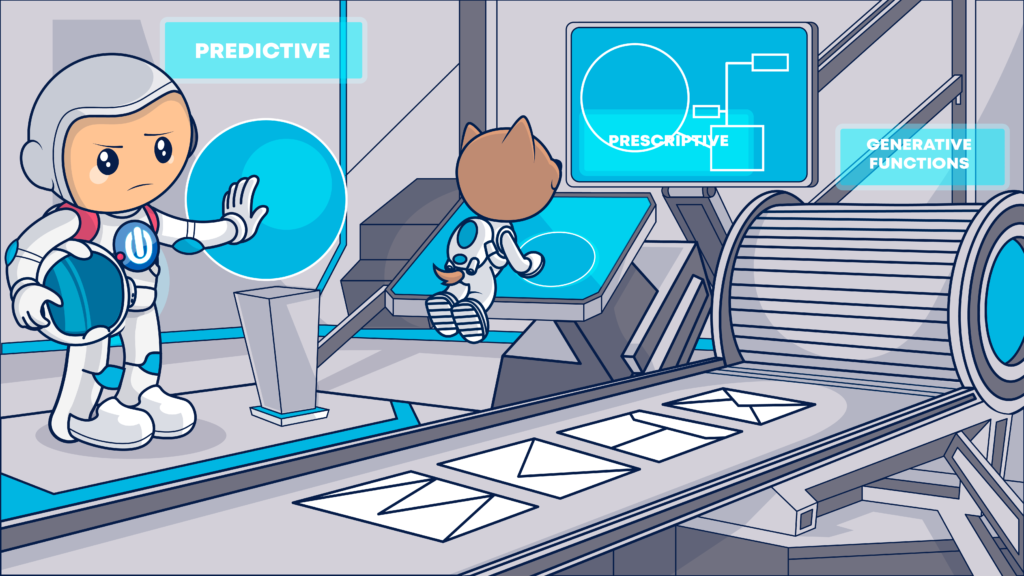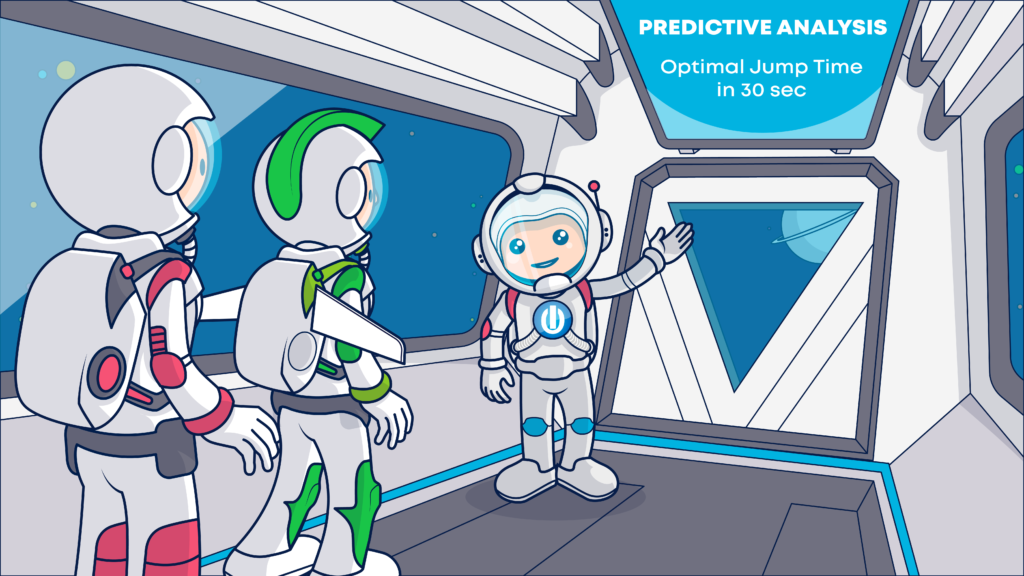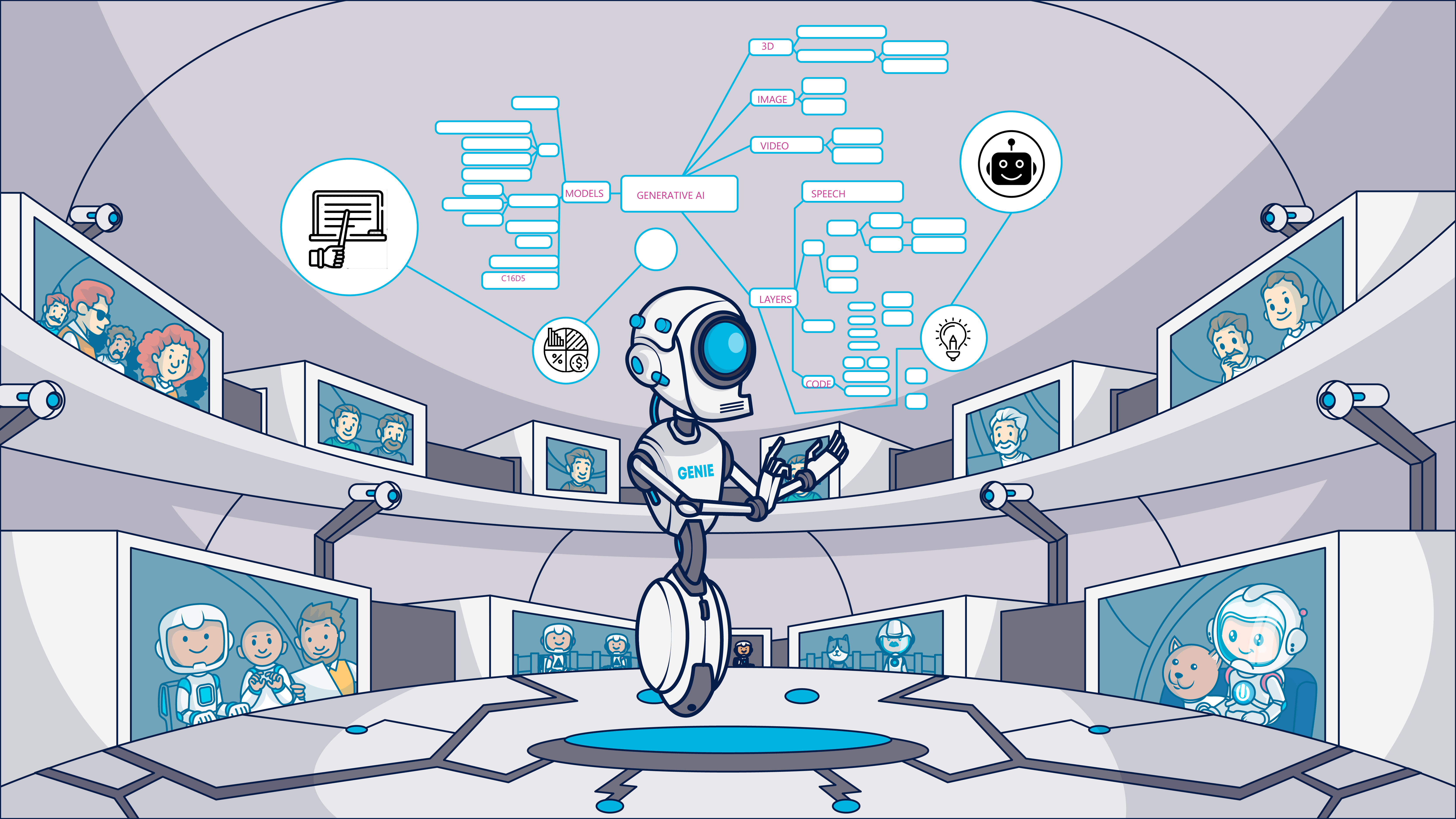At the beginning of 2023, generative AI, especially ChatGPT, became the technology everyone was talking about. Suppose you haven’t jumped on the AI bandwagon yet. This post will update you about everything AI, including what happened, what’s about to happen, and what email marketers can achieve with the help of these new intelligent tools.
Unless you’ve been on a digital sabbatical, you’ve probably heard about ChatGPT by now. In fact, you might have been relieved when the marketing world turned its attention to buzzing about Threads. 🧵
This summer’s battle of the billionaires for social media dominance provided a much-needed break from the dueling predictions that AI would save the world versus destroy humankind.
But seriously, setting aside all the bold proclamations and dire prophecies, what is the big deal with generative AI?
Why are marketers jamming the digital channels with talk about ChatGPT?
And, more importantly, can AI content writing replace human-crafted content in your email marketing campaigns?
Well, as with most things (whether artificial or human), the answer is complicated.
The short answer is the capabilities and use cases for artificial intelligence continue to expand. Already, you can use AI to do some amazing things in marketing, from automating reporting to conducting intelligent conversational interviews to replacing sales reps on a difficult client call.
Applications and tools employing sophisticated AI systems are proliferating so quickly that we need AI to help us keep track.
The generative powers of ChatGPT are something to behold, too.
Under the right conditions, er, prompts, ChatGPT can streamline content processes and improve outputs.
Marketers are as excited as those in any other business to find a set of tools that enable them to increase productivity and revenue while reducing costs. It ain’t all sunshine and roses just yet, though.
In this article, I’ll share what I’ve learned about generative AI in general, ChatGPT, and how to use these and other types of AIs in email marketing.
So c’mon.
You have to learn about this AI stuff sometime. Now is the time.
Artificial intelligence for marketing: Huh, yeah, what is it good for?

I’m going to be honest with you. If you just got excited about AI for marketing when OpenAI launched its generative AI tool called ChatGPT and made it free to use in November 2022, you have some catching up to do.
Artificial intelligence isn’t new, and many of us use tools that employ some form of AI daily. It’s the algorithms! They analyze, they process, and they tell us stuff.
What makes ChatGPT special is that it’s conversational, meaning it can process human-like, natural language, and it’s been trained using a massive set of data. They even got human feedback (reinforcement learning from human feedback, a.k.a. RLHF) along the way to help the machine learn from its mistakes.
The results are pretty cool. I mean, if you thought a Magic 8 Ball was fun at parties 🎱–this ChatGPT stuff is out of this world!
By the way, the acronym, “GPT,” may refer to the phrase, “general purpose technology.” This is technology that has many uses such as batteries or the internet. However,in the context of machine learning (and ChatGPT), the letters are an abbreviation for “Generative Pre-trained Transformer.”
If you think about it, what OpenAI did for the artificial intelligence industry was to achieve marketing excellence. The technology was free and accessible, and new users reached their Aha! moment almost instantly.
It’s a marketing coup, really.
But also, artificial intelligence and machine learning applications really do have the potential to, if not save the world, substantially aid the humans who are striving to do so.
I’m not saying anyone’s going to end climate change with the perfect, synthetically generated email subject line. (Speaking of subject lines, we can help you with those. Check out our guide to writing email subject lines to uncover our best tips, and with what you’ll learn here, it will x10 your capabilities.)
Technologists, scientists, researchers, and planners are using AI’s ability to search and process huge data sets and to create synthetic models for testing real-world scenarios to discover ways to reduce energy use, improve healthcare outcomes, and all kinds of other great stuff.
But, having said all the above, AI can’t replace marketers yet. It’s only good at showing you what “the right answer sounds like,” so you’re still needed on the prompt front lines.
Marketers have yet to discover much of AI’s potential
Marketers have embraced generative AI tools like ChatGPT to create content. However, the real value of AI for email marketers, including generative AI, lies in its other applications.
Asking AdAge readers, Is your organization ready to embrace AI-driven commerce?, Derek Fridman notes,
“While many brands have focused on experimenting with AI-generated video and ad copy, or refining their ad platforms for better targeting, they have only scratched the surface of the possibilities.”
Marketing teams benefit from AI innovations such as sentiment and frequency analysis, conversational intelligence, predictive analytics, data normalization and integration, process and content audits, and combining data from revenue, email, and social media analytics tools, or workflow and productivity optimizations.
Check out this cool AI use cases graphic from persona and market research solutions provider Delve.ai. ⬇️

Your email marketing program can use AI tools for audience targeting, list hygiene, content and delivery personalization, performance reviews, segmentation and behavioral analytics, competitor analysis, and template design.
Using the latest versions of AI tools, organizations can gain insights and change campaigns in real-time or near-real time. AI-assistance allows brands to take personalization to a whole new level–and you can expect consumers’ expectations to rise as a result.
AI applications that combine demographic, psychographic, and sentiment data can alter the tone of voice or localize the language of your emails at the moment of sending and for individual contacts.
How do AI systems do all these things? I put together some notes for you.
AI, machine learning, natural language processing: What does it all mean?
Artificial intelligence begins as a broad category of machines (computer systems) designed to mimic human intelligence. Simple AI applications are trained (or programmed) to perform repetitive tasks like identifying and eliminating duplicate or inaccurate contact entries in a CRM.
More complex systems can analyze unstructured or unlabeled data, such as social media posts or customer reviews, and identify words and phrases that indicate sentiment or emotion.
These types of AI-powered analytics tools can support sales and marketing teams by honing in on high-intent prospects and identifying customers at risk for churn or helping your PR team get out in front of a potential crisis.
Modern AI tools are multi-taskers, too.
The app that alerts your team to a churn risk can also suggest tactics and talking points or even provide a customized script or email to aid in recovery.
Generative AI is among the most advanced categories of artificial intelligence and combines many of the capabilities of other AI system types to organize, process, and repurpose data.
Generative AI vs predictive or prescriptive AI: What’s the difference in how marketers use these systems

Marketers use AI tools to help them review the past, predict the future, make decisions, and, now, with generative tools, make stuff.
You might categorize these activities as predictive, prescriptive, or generative.
But as technology advances, the lines between these categories continue to blur.
What predictive AI tools can do for marketers
Predictive AI tools include forecasting, detection, and assessment tools. Predictive AI processes often derive some or all of their data from descriptive analytics–this is the process of evaluating, organizing, and summarizing a data set (in other words, describing the data).
These algorithms evaluate large masses of data to answer the question, “Based on what happened in the past or is happening now, what can we expect to happen in the future?”
Product recommendation engines like the ones used to insert dynamic product suggestions into your subscribers’ emails often employ predictive AI. In this use case, predictive AI is used to answer questions like,
- Based on what the target user purchased in the past, what items are the target user most likely to want to buy? Or,
- Based on the purchases made by others who share similar attributes to the target user, what items are the target user most likely to want to purchase?
As marketers gain the ability to integrate data from multiple sources and leverage real-time data to drive insights, the power of predictive AI to build individual experiences at scale is scaling, too.
How marketing teams use prescriptive AI applications
Prescriptive AI takes predictive AI to the next level by prescribing the next best action for marketers to take based on the available data. Individual send-time optimization is an example of the application of prescription AI to email marketing.
Aggregate send time optimization analysis tells you when the most likely best time to send is for a group of recipients based on historical data. Individual, predictive send time optimization narrows the output’s scope to the best time to send for each user.
Prescriptive, real-time send-time optimization evaluates the behaviors of the individual recipient to identify when they are actively viewing their inbox, then directs your email distribution agent to send that person’s email now.
Similarly, a recommendation engine’s individual output may be prescriptive, going beyond suggesting what a buyer is most likely to want and designating what items should be included in a dynamic email sent to that buyer.
There’s enormous potential for AI to speed up and improve the testing of marketing messages, audience segmentation, and other elements. Prescriptive AI tools allow teams to conduct multivariate tests across multiple segments and hyper-personalize the results.
You may have been able to accomplish some of these tasks manually, in theory. But in practice, the time and effort to executive hyper-segmentation made the costs exceed the value.
Leveraging AI’s processing power and speed, you can have it all.
Predictive and prescriptive AI may use descriptive and diagnostic analytics to come up with answers for you. However, understanding the why behind a certain outcome through diagnostic analytics is more important for predictive applications.
Generative AI has entered the conversation

According to the results of a survey produced by Capgemini, 89% of organizations will have established teams and dedicated budgets for implementing generative AI by the end of 2023.
Generative AI combines elements of all the earlier AI iterations into a system that can develop new content–often on the fly.
Conversation bots employ generative AI to pull language-based data from LLMs and use deep machine learning to adjust in response to new inputs. The better the conversational analytics and generation capabilities of the particular chat tool, the more human-like those responses will seem.
Programs like ChatGPT use both conversational AI and generative AI. Users input their requests in the form of natural language prompts or queries, and the application can interpret those inputs and develop output to respond.
Developing text-based content isn’t the only use for generative AI, though. Just as “traditional” AI can evaluate various types of input, including visual or auditory data, generative AI can form new outputs based on visual, auditory, or other components.
Generative AI content tools can create songs, sound effects, synthetic images, videos, movies, and full-blown video games!
Generative digital fabrication applications help 3D designers and architects design and test structures, simulating the use of different materials and installation conditions.
Marketers can use generative AI for creative tasks such as developing taglines or demo videos and creating simulated audience segments for testing proposed campaigns.
AI-powered tools can help us gather valuable insights about our customers’ behaviors and preferences and build personalized content experiences, notes Cassandra Rossa in the article, First Steps to Incorporate AI into Content Marketing – Omniscient Digital.
For email marketers, tools such as ChatGPT can help them develop content ideas, generate a selection of subject lines, headlines, or CTAs, and even modify an email template to fit a different persona or new campaign objective.
Using generative AI and someone else’s foundation model speeds up the process of creating a proprietary AI system.
Think of it like bringing home a puppy that’s already been house-trained. Your organization will still have work to do, but at least you’re out of the puddles-on-the-floor stage.
Do generative AI tools produce unique content?
One issue stirring controversy surrounding the use of ChatGPT and similar AI tools is the question of ownership. The data used to train LLMs like ChatGPT and feed their creative genius was gathered from the internet.
As that data is converted into content, people are asking—and litigating about—who owns the intellectual property.
Setting aside the question of copyrights, you might also ask,
Are generative tools actually creating new content?
Are the outputs from ChatGPT actually original or unique?
Well, it’s complicated.
But in a sense, they might be.
Have you ever heard someone refer to the infinite monkey theorem?
That’s the claim that “if you had an infinite number of monkeys typing at an infinite number of typewriters, they would eventually produce the entire works of Shakespeare.”
Yeah. Sure.
Attaining duplicates of Shakespeare’s sonnets using this method is probably unlikely. But, since there are a limited number of characters and symbols available to those monkeys on those typewriters, you could expect that many existing words and phrases would appear in their product.
Give the monkeys levers that print entire words rather than letters, and you’d likely get complete sentences that made sense.
The output of a generative system isn’t infinite-monkey random; it’s intentionally created.
Generative AI starts off a little like that infinite number of monkeys and typewriters. Except with the injection of machine learning and rules-based processes.
Generative AI takes characters, symbols, words, phrases, or sights and sounds. Then it learns how those inputs are related to one another and starts building a map of their interconnectedness.
Generative AI’s output is still derivative in the sense that it started with those characters and symbols, words, and phrases.
AI learned those relationships from studying someone’s data. Lots of someone’s data.
A recent post published on Wired, describes the backlash that ensued after a tech entrepreneur developed an AI application to analyze literary works to the displeasure of those works’ authors.
What’s the real deal?
Generative AI is not a ‘dreamed a dream and made it real’ creator but a ‘very good at separating and reassembling data in new ways’ creator.
But then again, aren’t many of us?
Generative AI tools can create a unique or new combination of known elements. Whether the outputs are wholly new works or clever collections is something we may still need to figure out. Nonetheless, using artificial intelligence to complement and supplement human efforts is here to stay–at least for as long as we can power the computers.
Still trying to figure out the language of Ai and how the latest advances fit into your martech stack?
No need to ask the 8-ball, here’s a crash course for you.
An email marketers’ cheat sheet for AI-related concepts
💡 Not all AI machines can learn.
Artificial intelligence is the branch of computer science concerned with creating machines and systems that can perform tasks that “normally require human intelligence.”
The simplest of AI systems employ rules sets, expert systems, knowledge graphs and symbolic AI or “Good Old Fashioned AI,” Pathmind’s Beginners Guide to Important Topics in AI, Machine Learning and Deep Learning explains.
Machine learning is a subset of AI that goes beyond being told what to do and can learn from exposure to inputs.
- 35% of companies worldwide use AI in their business and another 42% are investigating its uses, according to IBM’s Global AI Adoption Index 2022. I speculate that the proliferation of user-friendly tools following the release of ChatGPT 3 in November 2022 will accelerate adoption rates in 2023.
ML models use computer algorithms to process structured data, like the performance metrics from each of your last ten campaigns or the fields in your contact list. ML algorithms can process historical data (including immediate real-time input) to generate insights.
Headline analyzers and keyword ranking tools use machine learning to identify what’s hot and what’s not.
💡 Deep learning is ML that can learn (almost) independently.
Deep learning models are a type of ML but can do more than traditional ML models. Deep learning models process huge quantities of unstructured data and can derive connections between multiple large data sets. This ability to process unstructured data without depending on humans to first tag and categorize is a significant advantage in terms of speed and efficiency and one of the capabilities making generative AI possible.
Deep (machine) learning AI systems can analyze the transcripts of your business’s customer service calls to identify recurring words that may point to a problem with your product or with your customer support delivery.
A conversational analytics tool using deep learning can help you surface frequently asked questions by parsing incoming customer service requests and inquiries across multiple channels.
Some conversational analytics tools use deep learning to evaluate audio input. These tools can offer businesses insights into the effectiveness of their sales pitches or customer support. Just how angry was that customer?
💡 Small AI training models are used to develop limited-purpose AI tools but can’t support gen AI applications.
Not every learning system is a foundation system (I’ll explain why later).
Narrow or specific task AI systems may be trained using a smaller data set than a general purpose system intended to handle multiple tasks.
As you can imagine, smaller data sets are more manageable but more limited in the insights you can gain from them.
For example, you can learn only so much from a bounce report. Larger data sets allow more inquiries and produce a broader range of outputs. But of course, with more input comes the risk of more bad inputs (garbage in).
Using a limited data set enables businesses to maintain control over their inputs and focus their resources on acquiring the insights most relevant to their organization’s objectives.
💡 Training a general-purpose AI system requires data, lots of it.
Foundation models are used to create systems with broad applications. These models consist of large collections of data, often unlabeled or unstructured, from which the algorithms can learn.
Foundation models’ need for input is so massive that it is nearly impossible to obtain without drawing data from the whole of the internet.
Feed me, Seymour! 🌱
Foundation models are also called transformer or base models because their neural network architecture allows them to transform one type of input into another type. The machine does its own tagging and classifying!
Of course, it’s way more complicated than that, but I’m talking about email marketing and content, not AI engineering.
💡 All LLMs are foundation models, but not all foundation models are LLMs.
You may have noticed the acronym LLM (an abbreviation of “large language model”) pops up a lot in AI discussions.
That’s because most foundation models are language-based. These models are called “large” language models (LLMs) because their data and parameters are large compared to foundation datasets used to train single-purpose or narrow AI systems.
Bard, ChatGPT, and the generative AI image tools DALL-E and Midjourney (both of which use text-based descriptions to generate images) all use LLMs.
Tools such as Runway’s “Magic Tools” and Aug X’s “Augie,” which can create full videos, clone voices, and audio content get their guidance from text-based data as well.
We’ve predicted that it is only a matter of time before ESPs (other than Apple) support videos in email. When this capability becomes widespread, AI-powered applications like these will enable marketing teams to send their audiences customized video content at scale.
While today’s most popular foundation models are language-based, that doesn’t mean all foundation models must be language-based.
Google DeepMind’s generalist agent called Gato was built to reach “beyond the realm of text outputs” and perform tasks such as playing video games or controlling robotic arms.
Uh oh, I think I saw a movie about that. 😬
I think we’re safe, for now though.
According to Gato’s advocates and critics, non-language based models are limited by the unavailability of data from which to learn. As we learn to gather and access data in different formats, you can expect to see more non-LLM AI advances.
💡 Computer systems use natural language processing (NLP) to learn from LLMs.
How do machines turn words into sounds and images or copy or evaluate them to detect emotion and sentiment?
NLP is a type of AI system focused on the evaluation of human language patterns.
NLP is a core component of conversational AI, the type of AI used to drive interactive voice and chat tools that respond to human queries.
Suppose you’ve ever tried to learn a new language. In that case, you already know that the way human beings form sentences, choose their words, and add context through nearby words, as well as audio and visual cues, can make understanding a communication’s meaning and intent challenging.
(We examined how to use language and context to improve your email performance in our step-by-step guide to email copywriting mastery.)
NLP’s natural language understanding (NLU) branch enables computers to evaluate human language to detect sentiment and meaning. We can use these tools to find out what people say about our companies online and how they feel about our brand or products.
NLP’s natural language generation (NLG) branch tries to reproduce human language.
NLG is the process that fuels text-based generative AI tools, a.k.a. AI content writers.
💡 Building and maintaining AI training models is expensive and time-consuming.
While hundreds of models exist, Amazon, Facebook, Microsoft’s OpenAI, and NVIDIA are among the companies supporting large-scale foundation models.
The graphic (below) prepared by Life Architect’s Dr. Alan D. Thomson illustrates the key players contributing to the current AI foundation ecosystem.

I love the big “Next” section in this graphic.
Change is happening fast in the AI universe.
Just 3 months after launch, OpenAI’s GPT-4 took the top spot in Life Architect’s June 2023 Billboard Chart for Language Models. Meanwhile, the August 28 release of ChatGPT Enterprise set hearts afire among AI aficionados.
In the coming months, I expect to see many new applications that combine broad language models with narrow non-language data sets to create innovative tools for marketers (and other industries).
Get onboard the generative AI train. It’s going to be a big deal

In the near future, Generative AI will go beyond content creation. It’s going to be a source of resources far beyond the written word and will be able to help us express ourselves better and to the fullest possible extent, guiding our decisions with action-based data that we’ll be able to quarry from just about anything.
But until then, I’ll need to share a little confession.
And No! Not that! I did not use ChatGPT to write this article. Pinkie swear.
There are benefits to using ChatGPT and AI writing tools to help you get past blank-page syndrome or clean up copy that is almost there but just needs a little something.
But, I’m still very wary of relying on text generation to produce content where factual accuracy matters. The exception would be when you are using a model that pulls from proprietary or other “clean” data that you know to be reliable.
With that said, some marketers have been using AI to guide their decisions for years. Generative tools such as ChatGPT add new dimensions and make the power of AI more accessible to your team members.
Further expansions of data accessibility and increased computing power will make the capabilities of AI broader and easier to use.
Your customers and subscribers expect you to know what they want when they want it. AI tools are essential for integrating and connecting the dots between datasets and delivering on these expectations.
It’s important for email marketers to learn which of these AI tools can boost productivity and improve brand performance. Among the massive and growing collection of tools available, the trendiest or easiest-to-use application may not be the ones that deserves your attention.
But it is time to start paying attention–and developing the guidelines for how your team will use AI responsibly.
Now, I have one more piece of advice for you.
Before you add your next level of martech, make sure you’re building on a solid foundation by following the steps in our guide to setting up your email marketing operations.














